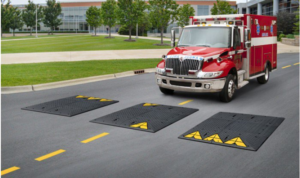Raised Crosswalk
To slow traffic along Kendal Drive, we propose a raised crosswalk be installed that connects the proposed sidewalk along Kendal to the new grass path, as picture in Figure 45 below. Raised crosswalks are ramped speed tables that span the length of the entire road. They are longer than the average speed bump and have a flat, table-like top section. Raised crosswalks offer a more gradual and less abrupt transition than speed bumps. This makes them less of a hindrance to large service vehicles like firetrucks, ambulances, and delivery trucks. Kendal Drive is the main entrance to the neighborhood, so it is crucial to minimize the impact on emergency vehicles that have to drive through, especially for senior residents who may require these services more often. For example, one of the residents mentioned how driving over an abrupt speed bump in the back of an ambulance can be quite uncomfortable. Pedestrians crossing along a raised crosswalk are also more visible to traffic, further increasing safety. Raised crosswalks have been shown to reduce speeds to 20-30mph which is a safe range for a residential street and will reduce speeding from vehicles that we recorded in the 30-45mph range.

The raised crosswalk would be 22 ft long by 24 ft which is the width of the road. The flat-top section would be 10 feet long, 3 inches tall, and have crosswalk markings. The ramp on each side of the flat section would each be 6 feet long increasing in height parabolically and have triangular markings to indicate to drivers where the ramp begins (see Figure 46). The flat, crosswalk section should be flush with the sidewalk and slope into the grass path to avoid a tripping hazard.

Cost-Efficient Alternative: Speed Lumps
An alternative to a raised crosswalk is installing speed lumps before a crosswalk. Speed lumps or speed cushions are like speed tables that have been separated into sections that are spaced to allow emergency vehicles to pass through without hindrance (see Figure 48). This alternative is less expensive than a raised crosswalk (see cost analysis) and better accommodates emergency vehicles. Rubber speed lumps may not last as long as asphalt, but are less expensive, less intrusive to install, and can be removed with minimal damage to the road. While speed lumps have some advantages over raised crosswalks, the benefits of reducing the speed of traffic only applies if cars stay in their lane. If cars move to the middle of the road to use the gaps, they can reduce the effectiveness of the speed lumps. Furthermore, we received feedback about a previous attempt at traffic calming on the street that involved staggered speed bumps which cars would drive around and treat as a “slalom.” A yellow road line should be implemented to discourage cars from crossing into the middle of the lane. The lumps can also be spaced so that only firetrucks can fully benefit from the gaps. Speed lumps can be an effective alternative, but we still recommend raised crosswalks because this behavior (that we call the “slalom effect”) cannot be completely prevented.


| Option | Material Cost | ||
| Raised Crosswalk | High | $8,000 | |
| Low | $5,000 | ||
| Speed Lumps | High | $5,000 | |
| Low | $2,000 | ||
Road Lines
Kendal Drive is the only entrance and exit to Kendal, and it is downhill from Enfield Road. The road has two-way traffic and a posted speed limit of 19 miles per hour. This road is only 24 feet wide from edge to edge, which equates to about 10 feet for each “lane” of travel, accounting for the white lines and small shoulders on the edge of the road. For comparison, most roads have a travel lane of 10 to 12 feet wide but larger shoulders of about 4 to 6 feet wide in addition to 1 to 1.5 feet in the middle for the double yellow line (MUTD, p 538). Currently, there is no line down the middle of Kendal Drive separating the two travel lanes, and we found in our traffic study that people often speed in both directions. We are proposing that a single yellow line be painted down the middle of the road. This would emphasize the fact that this is a two-way road and visually constrict drivers to a smaller space. However, it would not physically impede larger vehicles, such as delivery trucks and emergency responders, as they are entering or leaving Kendal.
Road lines are typically 6 inches wide, and cost about $5 per linear foot (VDOT Guide). Kendal Drive is approximately 950 feet long, which would equate to around $4750 per line. The next question is a single versus a double yellow line. Double yellow lines are more common on larger roads with higher speeds. Since Kendal Drive is narrower with slower speeds, we are proposing a single yellow line. This also helps keep cost down, and provides less of a visual impact on the aesthesis of Kendal. The figure below shows a visual of what the road would look like with a yellow line.
